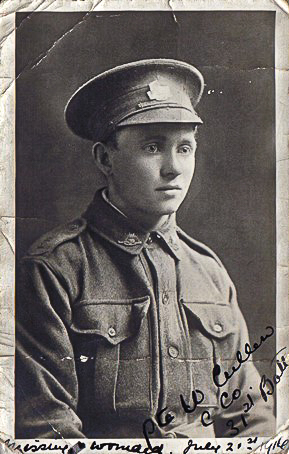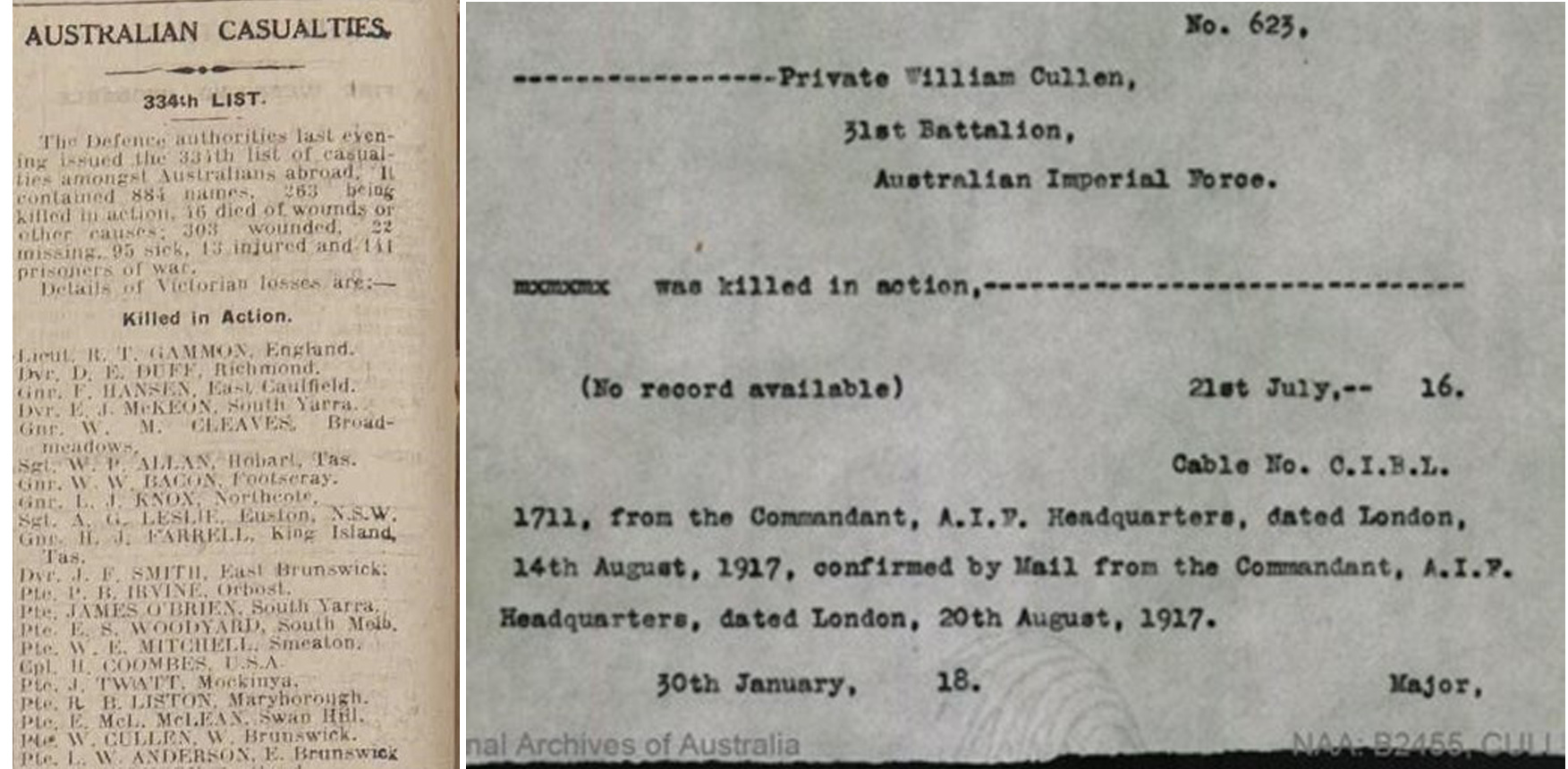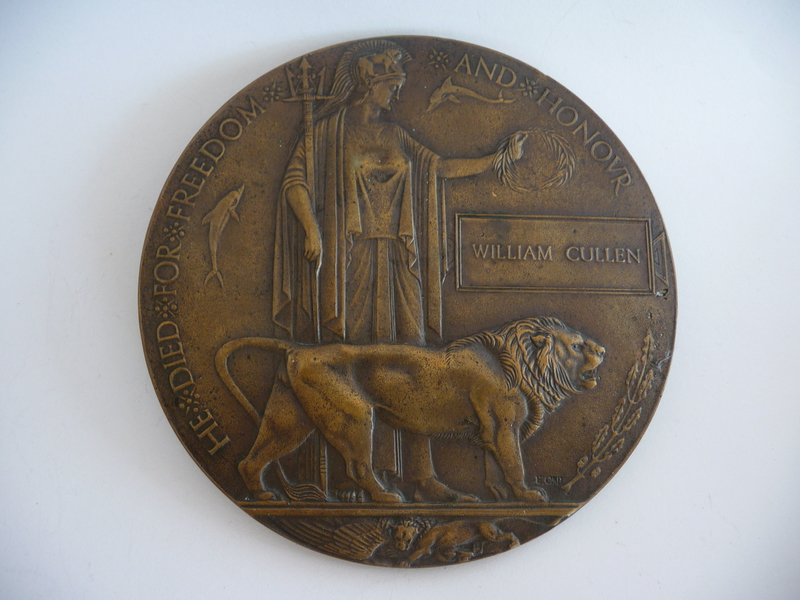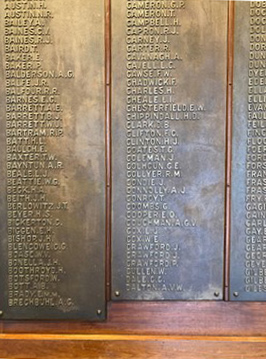William Joseph CULLEN
Eyes blue, Hair light brown, Complexion medium
William Cullen - “We Never Gave Up Looking”
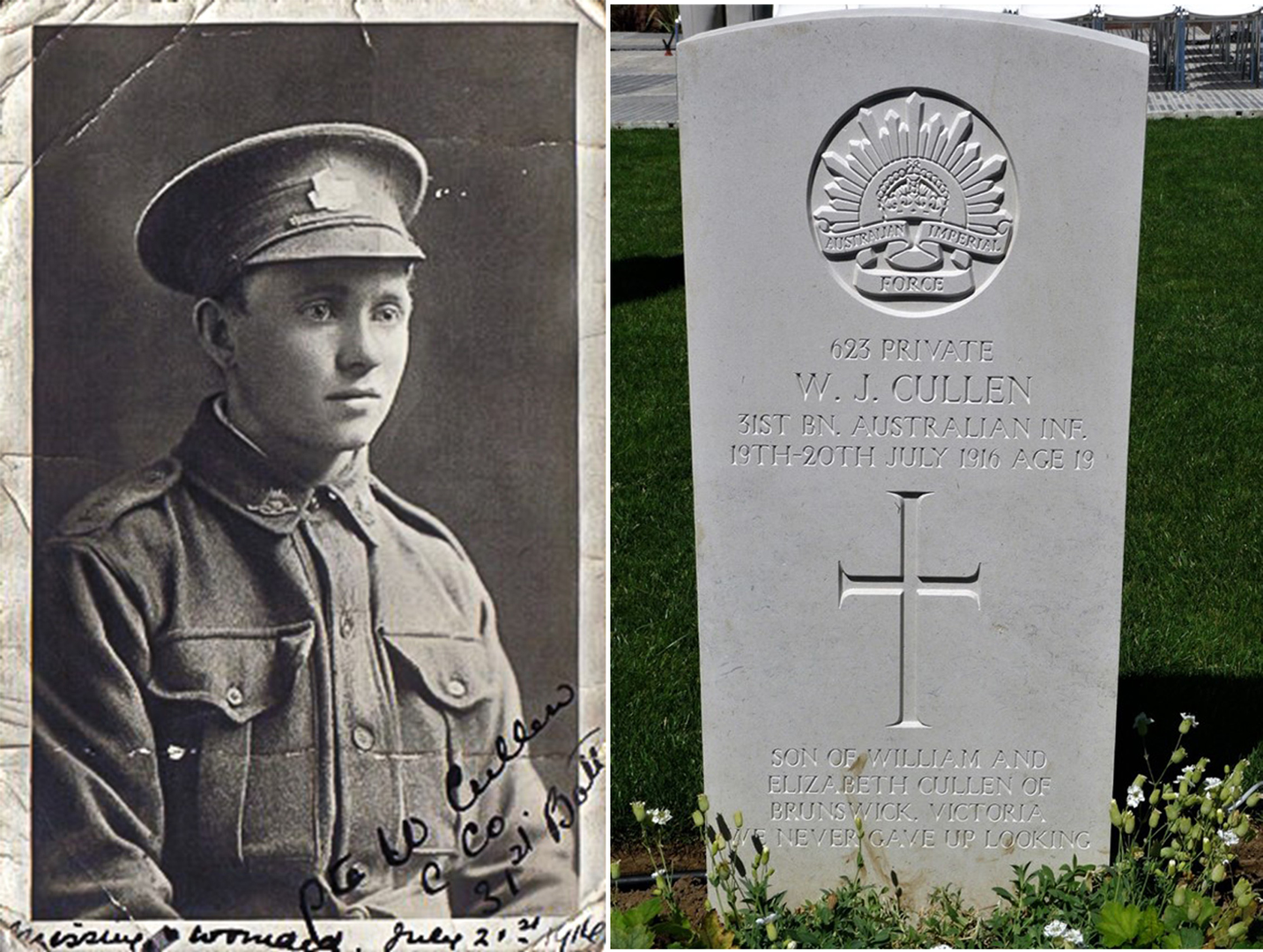
The Cullen Family of Carlton, Victoria
With appreciation to William’s Great Nephew Richard MacNeil for this story and photographs.
William Joseph Cullen was born on 18 May 1897 in North Carlton, Victoria to Elizabeth (nee) Madden (born at Buninyong near Ballarat in 1857 to Irish parents on the goldfields) and William Cullen (born in 1842 at Cape Town, in the Cape Colony in what is today South Africa, to Irish parents).
Unfortunately, Elizabeth died in June 1900, six weeks after giving birth to her daughter Josephine, so young William and Josie were sent to be cared for by relatives in the country for a couple of years. Their father William re-married in August 1902, soon after which William (junior) and Josie returned to live with their father, elder sisters, and stepmother at 32 Sutherland St, West Brunswick. William and Josie attended West Brunswick Primary School.
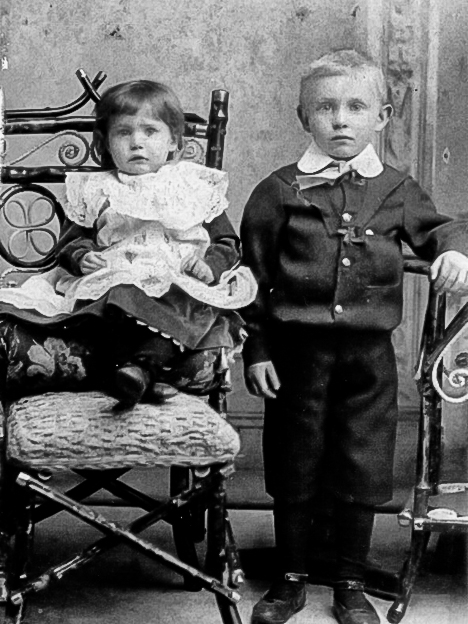
Military Service
William worked as an apprentice stove fitter at the Metters Stove Company, probably at age 16. He also had joined the 59th (Brunswick and Coburg) Battalion of the Citizen Military Forces in 1911 as a cadet, rising to senior cadet and remained with the unit for four years. When the War broke out, William tried to enlist in the AIF, but was rejected on the grounds that his chest measurement did not meet the required standard – at 162 cms and weighing 64 kgs, he was a small lad.
He reapplied on 9 July 1915 in Melbourne, at just 18 years and 2 months old, and was accepted. He was assigned service number 623 and was allocated to the 31st Battalion, A Company at Flemington on 14 July 1915. On 12 August 1915 he was transferred to C Company of the 31st Battalion at Broadmeadows Camp north of Melbourne where he continued his training as an infantry soldier. Some of the elements of the battalion had been raised in Queensland and in early October 1915 these were sent to Broadmeadows to join with the rest of the unit.

Off to Egypt
On 9 November 1915 William and the rest of C Company boarded the troopship HMAT Wandilla (ship A62) at Port Melbourne and sailed for Port Suez, disembarking there on 7 December 1915. For the next six months the battalion continued to train while in Egypt. Their initial assignments were in Zeitoun, Serapeum and Tel el Kebir, training and guarding the Suez Canal. When they left Serapeum there were no trains for the move and were transported for the 60 km trip in “dirty horse trucks”. At the end of March they were moved to Ferry Post and Duntroon and were in Moascar in the end of May.
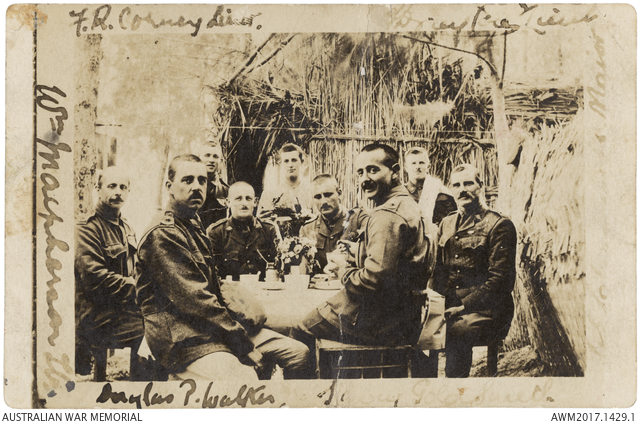
Private William Cullen No. 623, C Company, 31st Battalion, is the young man standing third from left, face partially obscured
(Note: The photo above belonged to William Cullen’s sister, Mrs Josephine Elizabeth MacNeil (nee Cullen). It was sent to her in Melbourne by her brother William, after he had the C Company officers sign their names around the edge of the photo card. The photo was donated to the Australian War Memorial by William’s nephew (Josephine’s son), the late John MacNeil, and his sister Margaret.)
The months passed in training and sightseeing, but by the time the 31st Battalion was transferred to France, the men were all heartily sick of Egypt. Private Les Smith’s letter home pretty well sums it up:
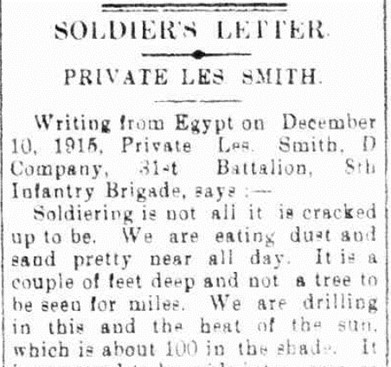
To the Western Front
On 17 June 1916 the 31st Battalion embarked at Alexandria on the troopship HMT Hororata for Marseilles, disembarking there on 23 June 1916. The battalion strength was 1019 soldiers. They then took trains to Steenbeque, 35 km from Fleurbaix, arriving on 26 June. Training continued, with how to handle poisonous gas included in their regimen. They began their move towards Fleurbaix on 8 July and by 11 July they were into the trenches for the first time, in relief of the 15th Battalion.
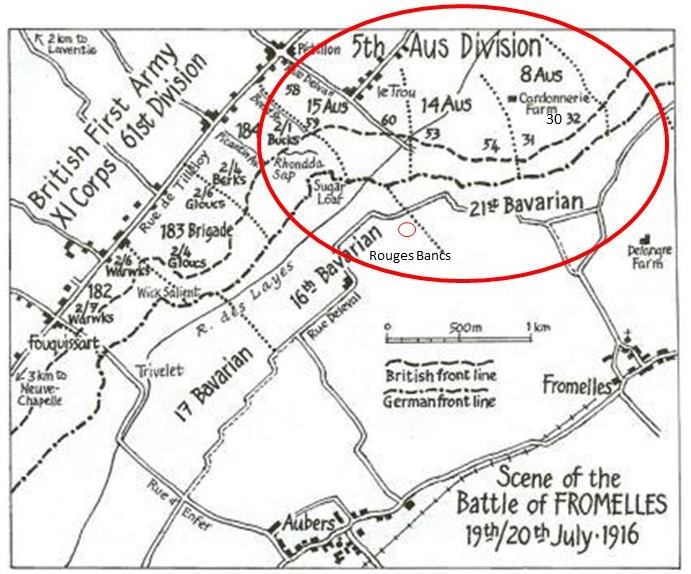
After their first experience in the trenches, they were relieved by the 4th NZ on the 16th. An attack was planned for the 17th, but bad weather caused it to be postponed. On the 19th they were back into the trenches and were in position at 4:00 PM. The assault began at 5:58 PM and was in four waves, with A and William’s C Company in the first two waves and B and D Company in the 3rd and 4th waves.
“Just prior to launching the attack, the enemy bombardment was hellish, and it seemed as if they knew accurately the time set”.
The pre battle bombardment did have a big impact on German first line trenches and the 31st quickly advanced to second line, which was mostly ditches filled with water. Even with the initial support, they remained under heavy artillery from both sides.

Unfortunately, with the success of their attack, ‘friendly’ artillery fire caused a large number of casualties. They were able to take out a German machine gun in their early advances, but they were being “seriously enfiladed” from their left flank. Fighting continued throughout the night, with heavy firing from concealed machine guns from farms, Delangre Farm and houses. At 5:30 AM the Germans attacked from both flanks in force and with bombing parties. Having only a few grenades left, the only resistance the 31st could offer was with rifles.
“The enemy swarmed in and the retirement across no man’s land resembled shambles, the enemy artillery and machine guns doing deadly damage.”
The 31st were out of the trenches by the end of the day on the 20th. From the 1019 soldiers who left Egypt, the initial impact was assessed at 72 soldiers killed, 581 wounded and 85 missing. The ultimate total was that 161 soldiers were either killed or died from wounds and of this total 82 were missing/unidentified. The bravery of the soldiers of the 31st was well recognised by their own Battalion commanders and Lt. General Haking.
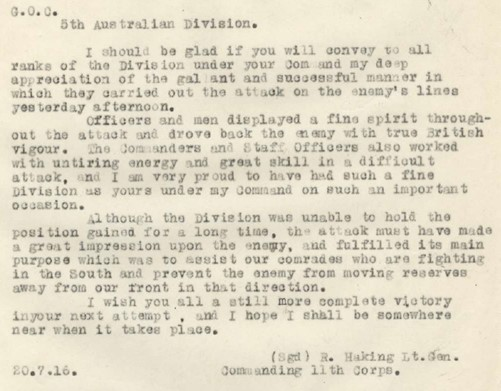
What Happened to William?
Soon after the battle, news started to filter back to the families of those killed, wounded, missing and taken prisoner at Fromelles, but few details were available.
In August 1916, just a month after the battle, William’s father received a generally encouraging telegram indicating that William had been wounded, but not seriously.
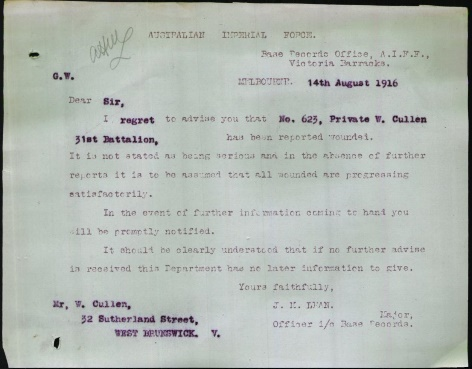
His status did change to wounded and missing in mid-September, which was communicated to the family. William’s father, holding out hope that William was alright, was active in seeking more information. With nothing else coming from the Army, he wrote to the Prisoners of War Help Committee in the UK in October 1916 seeking information on his son.
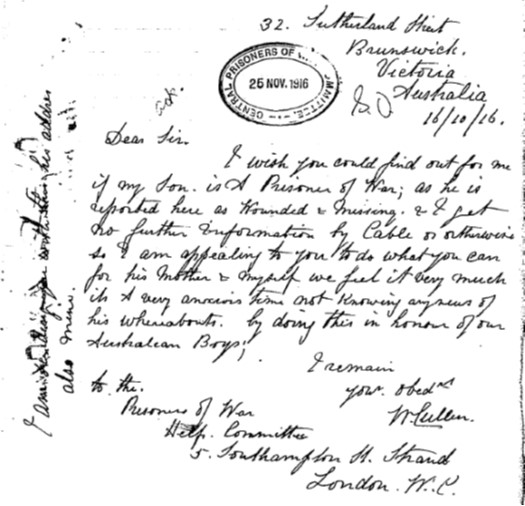
William’s Father’s Letter 16 October 1916
William (senior) even issued enquiry cards.
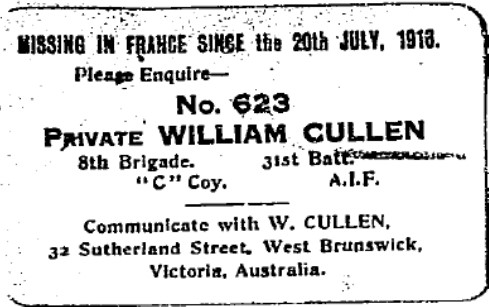
Two months later he received a reply to his query, but no news.
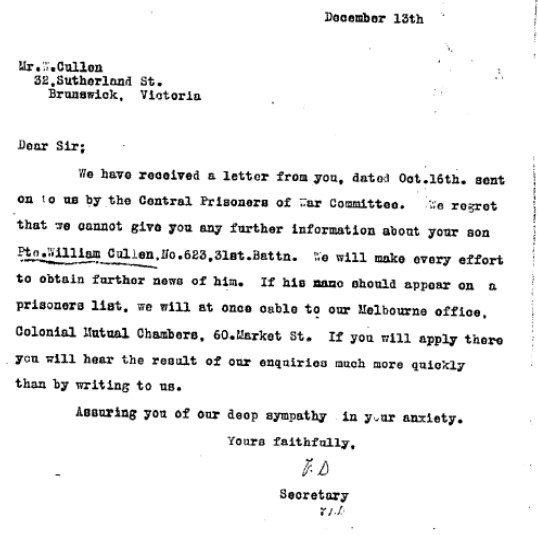
No further information was provided until William was finally confirmed as Killed in Action by a Court of Inquiry in the Field on 1 August 1917. This was reported in ‘The Bendigo Independent’s’ Casualty List No. 334 on 1 September 1917, but the formal notification from the AIF to the family did not come until 30 January 1918, 18 months after he had been killed.
While there were communications about William’s death, further details about how he died were not recorded until 1919 when a witness statement from Sergeant O.J. Alsbury (577) was obtained. William’s official records state that he was killed on the 21st, but this does not align with the battle, nor with the witness statement which noted that at some point in the evening of the 19th, William had been killed instantly when a shell exploded next to him. While this statement is from 1919, hopefully for the family Sergeant Alsbury was able to contact them long before this.

From the initial news of being wounded, to no POW news, then many months of nothing, to finally being declared as killed in action with no known grave, there was no closure for the family and friends.
One of his friends, May Scruby (perhaps his sweetheart), placed the following memorial in the newspaper The Age, 5 September 1917.
CULLEN – In loving memory of my dear friend, Private W. Cullen, killed in action on the 19th July, 1916 (previously reported missing).
Just when his life was brightest,
Just when his life was best,
He was called to do his duty,
And was sent to eternal rest.
Inserted by his loving friend, May Scruby.
The Family Found a Clue to a Burial Site
When checking William’s Army records many years later, the file note below was found, providing a potential location for William’s burial at “Fleurbaix”, which was how Fromelles was referred to by the Army in 1916.

William’s family also checked the records of 39 men of the 31st Battalion who were recorded as KIA on “21 July 1916”. From the research by Robin Corfield for his authoritative book on the battle of Fromelles, ‘Don’t Forget Me Cobber’, it is increasingly widely accepted that Cullen, along with most of these soldiers were actually killed during the battle.
Many of these soldiers also had similar burial annotations, indicating that at some time the Army had gained information on the burial of these men by the Germans. While this specific map reference of William’s burial is several kilometers from the site of the battle, the overall questions around these men’s fate eventually assisted in persuading the Army that some of these men could have been amongst the unidentified Australian soldiers whose remains were exhumed at Pheasant Wood near Fromelles.
After persisting with this suggestion, the Army eventually agreed to take a DNA sample from William’s niece Margaret. In 2008 the family were told that William had been identified, and he could finally be given a recognised place of burial in the new war cemetery at Fromelles which was officially opened in 2010 by HRH Prince Charles and Quentin Bryce, the Governor General of Australia.

Finally, after 94 years, closure for the family.
As inscribed at the base of William’s headstone:
“We Never Gave Up Looking”
William is also commemorated at:
The Fromelles Association would love to hear from you

Contacts
(Contact: royce@fromelles.info or geoffrey@fromelles.info).
(Contact: army.uwc@defence.gov.au or phone 1800 019 090).
Donations
If you are able, please contribute to the upkeep of this resource.
(Contact: bill@fromelles.info ).
